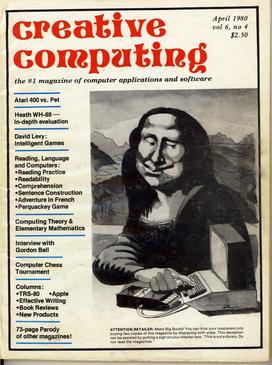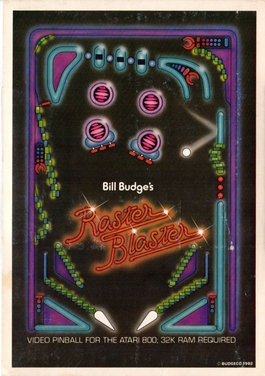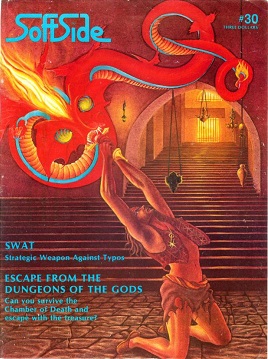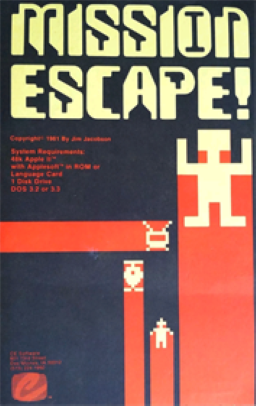Related Research Articles

Zork is a text-based adventure game first released in 1977 by developers Tim Anderson, Marc Blank, Bruce Daniels, and Dave Lebling for the PDP-10 mainframe computer. The original developers and others, as the company Infocom, expanded and split the game into three titles—Zork I: The Great Underground Empire, Zork II: The Wizard of Frobozz, and Zork III: The Dungeon Master—which were released commercially for a range of personal computers beginning in 1980. In Zork, the player explores the abandoned Great Underground Empire in search of treasure. The player moves between the game's hundreds of locations and interacts with objects by typing commands in natural language that the game interprets. The program acts as a narrator, describing the player's location and the results of the player's commands. It has been described as the most famous piece of interactive fiction.
Akalabeth: World of Doom is a role-playing video game released in 1979 for the Apple II. It was published by California Pacific Computer Company in 1980. Richard Garriott designed the game as a hobbyist project, which is now recognized as one of the earliest known examples of a role-playing video game and as a predecessor of the Ultima series of games that started Garriott's career.

Softporn Adventure is a comedic, adult-oriented text adventure game produced for the Apple II in 1981. The game was created by Charles Benton and released by On-Line Systems, later renamed Sierra On-Line. Years later, Softporn Adventure was remade and expanded as Leisure Suit Larry series of adult-oriented video games, and the first entry in that series, 1987's Leisure Suit Larry in the Land of the Lounge Lizards, was a nearly direct graphical adaptation of Softporn Adventure. Another graphical version was released as Las Vegas for various Japanese computers in 1986 by Starcraft.

Creative Computing was one of the earliest magazines covering the microcomputer revolution. Published from October 1974 until December 1985, the magazine covered the spectrum of hobbyist/home/personal computing in a more accessible format than the rather technically oriented Byte.

Softalk was an American magazine of the early 1980s that focused on the Apple II computer. Published from September 1980 through August 1984, it featured articles about hardware and software associated with the Apple II platform and the people and companies who made them. The name was originally used on a newsletter of Apple Software pioneer company, Softape, who in 1980 changed its name to Artsci Inc.

Bill Budge's Raster Blaster is a pioneering home computer pinball simulation written by Bill Budge for the Apple II and published in 1981 by Budge's company, BudgeCo. It was ported to the Atari 8-bit family. Raster Blaster resembles the Williams Firepower table from 1980.
Penguin Software was a computer software and video game publisher from Geneva, Illinois that produced graphics and application software and games for the Apple II, Macintosh, IBM, Commodore 64, Amiga, Atari 8-bit, and Atari ST computers. They produced the graphics programs Graphics Magician and Complete Graphics System, graphic adventure games such as the Transylvania series, arcade-style games like Spy's Demise, and role-playing video games such as Xyphus.

Super Invader is a fixed shooter video game written by Japanese programmer M. Hata for the Apple II and published by Creative Computing Software in November 1979. Super Invader is a clone of Space Invaders.

Computer Quarterback is an American football simulation video game written for the Apple II by Danielle Bunten Berry and published in 1981 by Strategic Simulations. Ports to the Atari 8-bit family and Commodore 64 were released in 1984. Add-on disks for new football seasons were also sold by SSI.

SoftSide is a defunct computer magazine, begun in October 1978 by Roger Robitaille and published by SoftSide Publications of Milford, New Hampshire.
Mark Pelczarski wrote and published some of the earliest digital multimedia computer software. In 1979 while teaching computer science at Northern Illinois University, he self-published Magic Paintbrush, which was one of the first digital paint programs for the Apple II, the first consumer computer that had color graphics capabilities.
California Pacific Computer Company is a defunct software company that published games and related software for the Apple II family of computers in the late 1970s and early 1980s. California Pacific is best known as the publisher of the first installment of Richard Garriott's popular Ultima game series, and for Super Invader, a Space Invaders clone voted the most popular software of 1978–80.
Quality Software is a defunct American software developer and publisher which created games, business software, and development tools for the Exidy Sorcerer, Apple II, and Atari 8-bit family in the late 1970s and early 1980s. Asteroids in Space, written by programmer Bruce Wallace, was voted one of the most popular games of 1978-80 by Softalk magazine.

Sargon III is a computer chess software. It is a sequel to Sargon II.

Bill Budge's Space Album is a collection of four Apple II action games written by Bill Budge and published by California Pacific in 1980. The games are Death Star, Asteroids, Tail Gunner, and Solar Shootout. Death Star was based around a scenario similar to the Death Star "trench battle" that formed the climax of the 1977 film, Star Wars Episode IV: A New Hope. Asteroids was a variant of the popular arcade video game of the same title.

Mission Escape! is a 1980 video game published by CE Software for the Apple II, programmed by Jim Jacobson.

Computer Acquire is a 1980 video game published by Avalon Hill for the Apple II, Atari 8-bit family, Commodore PET, and TRS-80.

Planetoids is a clone of Atari, Inc.'s Asteroids arcade game published by Adventure International for the Apple II in 1980 and TRS-80 in 1981. Each was originally an independently sold game, neither of which was titled Planetoids. The Apple II version, written by Marc Goodman, was published as Asteroid. The TRS-80 game was written by Greg Hassett as Fasteroids by Adventure Works. Fasteroids was still sold by Adventure Works at the same time Planetoids was available through Adventure International. The TRS-80 version includes features not present on the Apple II or arcade original.

The Keyboard Company, Inc., was an American electronics company based in Garden Grove, California. It was contracted by Apple Computer to produce the keyboards of their microcomputers in the late 1970s and early 1980s. The company also produced a number of peripherals separately for Apple's systems. Apple acquired the company in 1982 and renamed it the Apple Accessory Products Division (APD).
Margot Comstock was co-founder and editor of Softalk magazine, which was influential in the Apple II community, as part of a growing personal computing movement.
References
- ↑ Weyhrich, Steven (2010-07-02). "20 - Magazines". Apple II History: The Story of the Most Personal Computer. Retrieved 2022-10-14.
- ↑ Smith, William. "History of Softape / Artsci" . Retrieved 2022-10-18.
- ↑ Hague, James. "The Giant List of Classic Game Programmers" . Retrieved 2008-11-08.